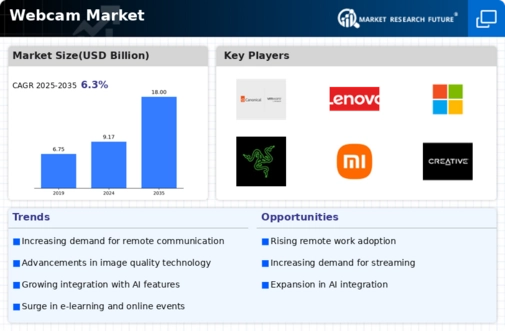Top Industry Leaders in the Webcam Market

The Competitive Landscape of the Webcam Market
Webcams, once the tools of video conferencing pioneers, have become ubiquitous companions in our digital lives. From facilitating remote work and education to fueling the rise of live streaming and online gaming, these humble eye-in-the-sky tools connect us across screens, bridging physical distance with pixelated presence. To thrive in this dynamic market, understanding the competitive landscape, adopted strategies, key players, and emerging trends is crucial for both established and aspiring participants.
Some of the Webcam companies listed below:
- Canon, Inc.
- Cisco Systems, Inc.
- D-Link Systems, Inc.
- Koninklijke Philips N.V.
- Lenovo
- Logitech
- Microsoft
- Razer Inc.
- Sony Corporation
- Xiaomi
Strategies Adopted by Leaders:
- Embracing Innovation and Cutting-Edge Technologies: Investing in R&D to integrate advancements like AI-powered noise cancellation, automatic background blurring, and advanced image processing algorithms for superior clarity and dynamic lighting adjustments differentiates solutions and caters to the evolving needs of users.
- Prioritizing User Experience and Design: Providing sleek, aesthetically pleasing designs, ergonomic mounting options, and intuitive software interfaces enhances user experience and attracts design-conscious customers.
- Partnerships and Ecosystem Building: Collaborating with video conferencing platform providers, streaming platforms, hardware manufacturers, and software developers expands reach, offers complete solutions, and strengthens brand presence.
- Focus on Privacy and Security: Implementing industry-leading privacy certifications, achieving data security compliance, and transparent data management practices build trust and address growing concerns about online privacy.
- Sustainability and Environmental Considerations: Utilizing recycled materials, minimizing waste in production processes, and offering compliant packaging cater to customers with growing environmental awareness.
Factors for Market Share Analysis:
- Product Portfolio and Technological Breadth: The range and sophistication of webcams offered, encompassing diverse resolutions (HD, 4K, UHD), frame rates, field of view options, built-in microphones, and additional features like autofocus, low-light performance, and facial recognition, significantly impact market reach. Catering to specific applications, such as professional video conferencing, streaming, gaming, or security monitoring, requires tailored solutions and partnerships.
- Target Market Focus: Focusing on specific segments within the technology ecosystem, such as businesses, educational institutions, gamers, content creators, or individual consumers, requires customized marketing strategies and technical specifications addressing their unique needs. Solidifying market share hinges on understanding these sector-specific concerns.
- Ease of Use and Integration: Ensuring simple plug-and-play functionality, compatibility with diverse operating systems and video conferencing platforms, and user-friendly software for settings adjustments enhance accessibility and user experience.
- Security and Privacy: Implementing robust security features to protect against unauthorized access, data encryption protocols, and transparent privacy policies are paramount for building trust and mitigating concerns about data breaches and surveillance.
- Cost and Value Proposition: Offering competitive pricing, demonstrating clear value through high-quality performance, additional features, and long-term reliability cater to both budget-conscious users and professional clients.
New and Emerging Companies:
- Niche-Focused Specialists: Companies like Elgato and Brio specialize in developing high-performance webcams for professional content creators and gamers, offering features like ultra-fast frame rates, high resolutions, and specialized software for lighting control and green screen functionality.
- Mobile-Centric Solutions: Companies like Anker and Insta360 focus on developing webcams specifically designed for smartphones and tablets, offering portability, creative mounting options, and seamless integration with mobile apps for live streaming and content creation.
- Open-Source Hardware Advocates: Companies like Open Webcams and Hackaday promote open-source webcam designs and readily available hardware kits, empowering researchers and DIY enthusiasts with customization options and fostering innovation within the community.
Latest Company Updates:
Nov. 15, 2023, Opal unveiled the clip-on world's smallest Tadpole webcam. With a large, mirrorless sensor and six-element glass lens, the Tadpole webcam attaches easily to a laptop and connects via USB. The camera uses a 48-megapixel Sony IMX582 Exmor RS sensor capable of 1080p video with an f1.8 six-element glass lens to produce accurate color. The camera shoots in 4k but down-samples it to 1080p, so it's compatible with most video chat software.
Nov. 02, 2023, Dell unveiled a P3424WEB curved monitor with a webcam ideal for professional environments. The Dell P3424WEB curved monitor has a 2K QHD webcam, Microsoft Teams and Zoom certification, and a built-in KVM switch. It caters to video conferencing and multitasking needs. The versatile connectivity options and ergonomic design enhance the monitor's utility in professional settings.
Jun. 28, 2023, LG Electronics released an HD webcam for its TVs, the LG Smart Cam (VC23GA), enabling video calling and PIP video during workouts. It's a 1080p camera with dual microphones, a physical privacy shutter, and WebOS's multi-view feature support. It shows two apps in a split-screen view on the TV. The webcam is supported on any TV running webOS 22 or webOS 23. LG Smart Cam (VC23GA) enables videoconferencing at home using the webOS RemoteMeeting app, LG's web-based videoconferencing service.
Jun. 05, 2023, BenQ launched a 4k Webcam, Ideacam, that offers four distinct shooting modes, including a Sony 8MP sensor, almost 4K clarity, a 15X Macro lens, and integrated Ring Light. This innovative, high-performance dual-mode webcam empowers creative professionals in their video conferencing and presentation needs. The Ideacam's functionality is enriched with BenQ's EnSpire, which brings features like image freeze, live annotation, measurement display, and a dedicated remote control.
